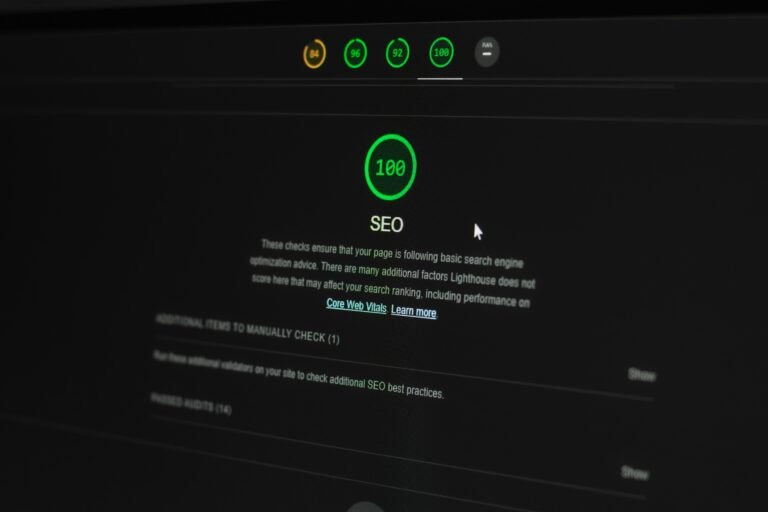Understanding SEO in Digital Marketing
Search Engine Optimization, commonly referred to as SEO, is a critical component of digital marketing aimed at enhancing visibility in online search results. It encompasses various strategies and techniques designed to optimize web pages, ensuring they rank higher on search engines such as Google, Bing, and Yahoo. The importance of SEO in digital marketing cannot be overstated, as it facilitates better visibility, ultimately leading to increased website traffic and improved business performance.
SEO operates by leveraging specific algorithms that search engines employ to provide users with relevant results. By aligning a website’s content and structure with these algorithms, businesses can improve their chances of appearing on the first page of search engine results. This is vital, considering that a vast majority of users tend not to click beyond the first few results displayed, making ranking a top priority for online brands.
Furthermore, SEO enhances user experience, a principle that is increasingly emphasized by search engines. Content that is well-organized, relevant, and user-friendly encourages visitors to spend more time on a website, thereby reducing bounce rates and increasing engagement levels. High-quality content that addresses user needs and interests not only attracts visitors but also increases the likelihood of conversions, turning leads into customers. In this way, SEO plays a foundational role in driving traffic while simultaneously improving overall user satisfaction.
Incorporating SEO into digital marketing strategies is essential for brands aiming to optimize their online presence. As search engines continuously evolve, adapting SEO practices accordingly is necessary for maintaining competitiveness in the digital marketplace. By understanding how to use SEO effectively, businesses can harness its power to not only amplify their online visibility but also boost their overall marketing efficacy.
Key Components of SEO
Search Engine Optimization (SEO) is a multifaceted approach essential for elevating the visibility of websites within search engines. The primary components of SEO can be categorized into three main categories: on-page SEO, off-page SEO, and technical SEO. Each of these components plays a critical role in creating a robust digital marketing strategy.
On-page SEO encompasses all the tactics implemented directly on the website to improve its position in search rankings. This includes the optimization of content with relevant keywords, enhancing user experience through effective layout and design, and ensuring that the site is easily navigable. For example, utilizing header tags correctly can structure content, making it more user-friendly. Using descriptive title tags and meta descriptions further invites clicks from search engine result pages (SERPs), showcasing the importance of on-page SEO in attracting potential visitors.
Off-page SEO, on the other hand, concerns activities carried out externally to boost a website’s authority and relevance. One of the most critical elements is link-building, which refers to acquiring high-quality backlinks from reputable sites. These backlinks serve as endorsements, signaling to search engines that the content is credible and valuable. Social media marketing and influencer collaborations also fall under this category, facilitating broader visibility and engagement through shared content. This networking aspect demonstrates how off-page SEO contributes to building a brand’s reputation and authority online.
Lastly, technical SEO addresses the backend aspects of a website that influence its performance. This includes site speed, mobile-friendliness, and secure connections, all of which are vital in today’s digital landscape. A well-structured sitemap aids search engines in navigating and indexing the site more effectively, promoting better overall search visibility. In essence, all three components of SEO—on-page, off-page, and technical—are interlinked, forming an integrated approach to effectively using SEO in digital marketing. Each component must work harmoniously to establish a powerful online presence.
How to Conduct Keyword Research
Conducting keyword research is a critical first step in developing an effective SEO strategy for digital marketing. Understanding the keywords that potential customers use when searching for products or services enables businesses to create tailored content that meets these needs. The process begins with brainstorming relevant topics related to your niche. Consider the products or services you offer, as well as the questions or problems that your audience might search for solutions to. This initial list will form the foundation of your keyword analysis.
Next, it is important to utilize keyword research tools to expand on your initial ideas. Tools such as Google Keyword Planner, SEMrush, or Ahrefs can provide valuable insights into search volume, competition, and trends. These platforms allow you to input your brainstormed keywords and examine related phrases that users commonly search for. Not only does this approach help uncover new keyword opportunities, but it also allows you to evaluate the level of competition for specific terms, guiding your selection of high-value keywords that can rank well in search engines.
Understanding search intent is another vital component in the keyword research process. Search intent refers to the purpose behind a user’s query, whether informational, navigational, transactional, or commercial. By identifying the intent of your target keywords, you can craft content that aligns more effectively with user expectations and needs. For instance, if you identify a transactional keyword, you may want to optimize your landing pages to facilitate conversions. Conversely, for informational keywords, creating valuable content that educates your audience could be more beneficial.
Finally, once you have gathered a comprehensive list of keywords, prioritize them based on relevance and potential impact on your marketing goals. Focus on a mix of head terms and long-tail keywords. Long-tail keywords generally have lower competition and can attract more targeted traffic, making them essential for enhancing your digital marketing strategy’s effectiveness.
Optimizing Your Website for SEO
To effectively harness the power of search engine optimization (SEO) in digital marketing, it is crucial to focus on optimizing various elements of your website. This process involves a comprehensive understanding of key components including meta tags, title tags, image alt text, and URL structures. Each of these elements plays a vital role in enhancing your website’s visibility and ranking in search engine results.
Meta tags serve as brief summaries of your web pages and are pivotal for both SEO and user engagement. The most important meta tag is the meta description, which should encapsulate the essence of the content while incorporating relevant keywords. For example, a meta description for a page about digital marketing strategies might read, “Discover effective digital marketing strategies through SEO optimization for improved visibility and engagement.” This not only informs search engines of the page’s content but also entices users to click through.
Title tags are equally significant as they inform search engines and users about the specific subject matter of a page. Ideally, each title tag should be unique and contain primary keywords related to the content. An effective title tag could be “How to Use SEO in Digital Marketing: Strategies for Success.” This succinctly conveys the page’s focus while appealing to search engine users.
Image alt text is another important SEO element, as it describes images to search engines that cannot view them. This practice not only contributes to accessibility but also boosts SEO. For instance, using alt text like “SEO digital marketing infographic,” can enhance your chances of ranking higher in image search results.
Lastly, URL structures should be clear and concise, using keywords where appropriate. A well-structured URL, such as “yourwebsite.com/seo-digital-marketing-guide,” allows both users and search engines to quickly understand the content of the page. By seamlessly integrating these elements into your website, you can significantly improve its overall search engine optimization, which is crucial for any digital marketing strategy.
Creating SEO-Friendly Content
Producing content that is optimized for search engines is crucial in the realm of digital marketing. Engaging content not only attracts readers but also encourages them to stay longer on the website, which signals to search engines that the content is valuable. To create SEO-friendly content, one must focus on the quality, relevance, and structure of the information presented.
One essential technique in crafting effective content is the strategic use of headings and subheadings. Utilizing headings (H1, H2, H3, etc.) not only enhances readability but also helps search engines understand the hierarchy and context of the information. Each heading should reflect the primary topic of the section and can naturally integrate keywords such as “how to use SEO in digital marketing.” This practice allows both users and search engines to skim through the content efficiently, leading to a better user experience.
Moreover, the integration of keywords should be done thoughtfully. They should appear naturally within the content—particularly in the introduction, concluding paragraphs, and throughout the body—while ensuring the flow of the text is not disrupted. Instead of forcing the keyword phrase “how to use SEO in digital marketing” repeatedly, synonyms and related phrases can provide diversity and enhance the content’s relevance. For instance, terms like “search engine optimization strategies” or “SEO techniques” can help in reinforcing the topic while keeping the content naturally readable.
Additionally, it is pertinent to focus on creating substantial and valuable content. Answering frequently asked questions, providing how-to guides, and sharing insights can elevate the reader’s experience and further optimize the content for search engines. When content addresses the audience’s needs and aligns with their search intent, it is more likely to rank higher in search results, therefore enhancing visibility in the digital marketplace.
Building Backlinks and Their Importance
Backlinks, also known as inbound links, are hyperlinks on one website that direct users to another website. In the realm of search engine optimization (SEO) in digital marketing, backlinks play a crucial role in determining the authority and relevance of a webpage. Search engines like Google consider the number and quality of backlinks as a crucial factor in ranking websites. A strong backlink profile not only improves a site’s visibility in search results but also boosts its credibility among users.
One of the primary reasons backlinks are vital for SEO is that they act as votes of confidence. When a reputable site links to your content, it signals to search engines that your information is valuable and trustworthy. Consequently, this can lead to higher search rankings, increased organic traffic, and ultimately more conversions. However, the quality of backlinks is more important than quantity; links from authoritative and relevant sources are much more effective in enhancing your SEO efforts.
To build a robust backlink profile, consider employing a variety of strategies. Guest blogging is an effective method; by writing high-quality articles for other websites in your niche, you can earn backlinks while showcasing your expertise. Additionally, reaching out to industry influencers and writers can provide valuable opportunities for collaboration, potentially leading to backlink acquisition. Creating shareable content, such as infographics or in-depth guides, can also encourage other sites to link back to your resources.
Monitoring your backlink health is equally important. Use SEO tools to track the performance of your backlinks and identify any links that may be harmful or low-quality. Regularly auditing your backlink profile can help you maintain a healthy link portfolio, ensuring that your efforts in SEO in digital marketing lead to sustained growth and improved rankings.
Utilizing Local SEO Strategies
Local SEO is an essential component of digital marketing for businesses aiming to attract customers within a specific geographic area. It involves optimizing a company’s online presence to ensure maximum visibility in local search results. This strategy is particularly important for small to medium-sized enterprises that rely on local clientele to drive sales. By effectively implementing local SEO tactics, businesses can enhance their online visibility, leading to increased foot traffic and sales.
One of the fundamental strategies for local SEO is to optimize Google My Business listings. Claiming and thoroughly completing a Google My Business profile allows businesses to provide essential information such as location, operating hours, and contact details. This free tool not only aids in appearing in the local pack results but also fosters customer engagement through reviews and Q&A features. A well-optimized listing can significantly boost a business’s chances of being discovered by potential customers in their immediate vicinity.
Moreover, managing online reviews is vital in the local SEO landscape. Positive customer reviews not only enhance credibility but also influence search engine rankings. Businesses should actively encourage satisfied customers to leave reviews and respond to feedback, both positive and negative. Engaging with customers in this manner not only builds loyalty but also signals to search engines that the business is trustworthy and reputable.
Incorporating local keywords is another critical element of local SEO. Businesses should research and use relevant keywords that potential customers are likely to search for, including the geographical location in their content, meta descriptions, and tags. By integrating these keywords naturally into web pages and blog content, businesses can increase their relevance in local search queries, enhancing visibility and attracting a more targeted audience. Implementing these local SEO strategies ensures that businesses are not only visible online but are effectively reaching their desired local customers.
Measuring SEO Success: Tools and Metrics
Measuring the success of SEO efforts is crucial to understanding how to use SEO in digital marketing effectively. Various tools and metrics are available to evaluate performance, analyze data, and make informed adjustments. One of the most widely used tools is Google Analytics. This platform provides comprehensive insights into website traffic, user behavior, and conversion rates. By tracking metrics such as organic search traffic, bounce rates, and user engagement, marketers can gauge the effectiveness of their SEO strategies.
Another essential tool is Google Search Console, which allows users to monitor website health in relation to search visibility. It provides valuable data on keyword performance, click-through rates (CTRs), and overall site indexing. Understanding which keywords drive traffic can assist businesses in optimizing their content around terms that resonate with their audience. Additionally, Google Search Console can help identify technical issues that may hinder SEO success, thereby enabling timely interventions.
Aside from Google tools, several third-party applications, such as SEMrush or Ahrefs, offer in-depth analysis of keyword rankings, backlink profiles, and site audits. These platforms provide comparative data against competitors, helping to determine market positioning and areas where SEO efforts can be improved. Metrics like Domain Authority and Page Authority are also pivotal for assessing overall SEO strength.
When interpreting data, it is vital to focus not only on aggregate numbers but also on specific metrics that align with business objectives. For instance, an increase in organic traffic is positive, but it’s essential to ensure that this traffic leads to desired conversions. Therefore, continuous monitoring and adjustment of strategies based on real-time data play a significant role in leveraging how to use SEO in digital marketing effectively for long-term success.
Conclusion: Implementing Your SEO Strategy
Throughout this comprehensive guide, we have explored the various aspects of how to use SEO in digital marketing to enhance online visibility and drive targeted traffic. From understanding the fundamentals of search engine optimization to implementing effective strategies, the key takeaways are essential for any digital marketing campaign.
Firstly, it is crucial to conduct thorough keyword research to identify the terms and phrases that resonate with your target audience. By understanding how potential customers search for products or services, you can create content that meets their needs and aligns with their search intent. Furthermore, on-page optimization plays a vital role in ensuring your website is structured effectively, with relevant meta tags, headers, and content that incorporates keywords naturally.
Moreover, off-page SEO techniques, such as building quality backlinks and engaging in social media promotion, can further elevate your digital marketing effectiveness. These strategies not only enhance your website’s authority in the eyes of search engines but also increase brand awareness among potential customers. Additionally, monitoring your SEO performance through analytics tools is essential to assess the effectiveness of your strategies and make data-driven adjustments as necessary.
As you embark on your journey to implement these SEO strategies, remember that SEO is not a one-time task but an ongoing process. Continuous learning and adaptation to evolving algorithms and consumer behavior are key components of successful digital marketing. Therefore, we encourage you to take actionable steps based on the insights gained from this guide.
For further assistance in enhancing your digital marketing efforts through effective SEO strategies, consider exploring additional resources or consulting with professionals in the field. Embrace the opportunities that SEO presents to improve your online presence and achieve your marketing goals.



